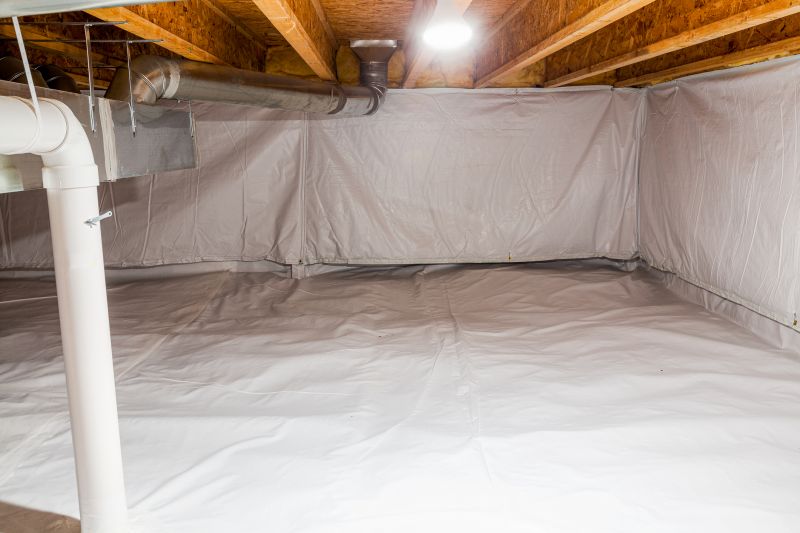Top Vapor Barrier Installation Products for Reliable Protection
Explore the leading materials and tools designed to ensure effective vapor barrier installation for durable, professional results.
 Vapor barriers are essential components in construction and renovation projects, serving to prevent moisture from penetrating walls, floors, and ceilings. Proper installation of vapor barriers can help protect building structures from mold, mildew, and water damage, contributing to healthier indoor environments. These barriers are typically made from materials such as polyethylene, polypropylene, or foil-backed sheeting, each offering different levels of durability and moisture resistance.
Vapor barriers are essential components in construction and renovation projects, serving to prevent moisture from penetrating walls, floors, and ceilings. Proper installation of vapor barriers can help protect building structures from mold, mildew, and water damage, contributing to healthier indoor environments. These barriers are typically made from materials such as polyethylene, polypropylene, or foil-backed sheeting, each offering different levels of durability and moisture resistance.
Top Overall Option
Polyethylene Vapor Barrier Sheet
A high-quality polyethylene vapor barrier sheet offers a versatile and effective solution for moisture control in various construction applications. Its durable, flexible material allows for easy installation across different surfaces, providing a reliable moisture barrier. When properly sealed and installed, it helps reduce the risk of moisture infiltration and related issues, making it a popular choice among builders and homeowners alike.
Types of Products For Vapor Barrier Installations
Polyethylene Vapor Barrier Sheets
Commonly used in crawl spaces and basements, these sheets are available in various thicknesses and sizes to suit different needs.
Foil-Backed Vapor Barriers
Reflective foil-backed membranes are often used in wall and attic insulation to enhance moisture resistance and thermal efficiency.
Liquid Vapor Barrier Coatings
Applied as a liquid, these coatings create a seamless moisture barrier on concrete, wood, or other surfaces.
Vapor Barrier Tape
Specialized tapes designed to seal seams and overlaps in vapor barrier sheets for a continuous moisture barrier.
Vapor Barrier Adhesives
Adhesives used to secure vapor barriers to surfaces and ensure airtight seals.
Polyurethane Vapor Barriers
Flexible and durable, suitable for various construction environments requiring moisture control.
Radiant Barrier Foil
Designed to reflect heat and moisture, often installed in attics and roofing applications.
Vapor Barrier Underlayment
Used beneath flooring materials to prevent moisture transmission from subfloors.
Polyethylene Bubble Wrap
Insulation combined with vapor barrier properties, suitable for certain retrofit applications.
Vapor Retarders
Materials designed to slow moisture transmission, used in various building assemblies.
Polypropylene Vapor Barriers
Alternative to polyethylene, offering similar moisture resistance with different flexibility properties.
Vapor Barrier Membranes
Heavy-duty membranes used in foundation or roofing applications to prevent moisture ingress.
Polyethylene Sheeting for Construction
Multi-purpose sheeting used for temporary moisture protection during construction projects.
Vapor Barrier Clips and Fasteners
Accessories that facilitate secure attachment of vapor barriers to surfaces.
Popular Choices
Widely used for moisture control in various construction settings, available in multiple thicknesses and sizes.
Commonly installed in attics and walls for moisture resistance and thermal reflection.
Essential for sealing seams and overlaps, ensuring a continuous moisture barrier.
Applied directly to surfaces like concrete or wood to create a seamless moisture barrier.
Flexible and durable, suitable for various moisture-sensitive areas.
Reflects heat and moisture, often used in attic insulation projects.
Used beneath flooring to prevent moisture transmission from the subfloor.
Alternative material choice offering moisture resistance for various applications.
Materials designed to slow moisture movement in building assemblies.
Accessories that assist in securing vapor barriers effectively.
Selecting the right vapor barrier involves understanding the specific needs of your project, including the location, climate conditions, and the surfaces involved. For example, thicker polyethylene sheets are often used in crawl spaces and basements, while foil-backed options may be preferred in wall assemblies to reflect heat and moisture. Proper installation techniques, such as sealing seams and overlaps, are crucial to maximize effectiveness and prevent moisture infiltration.
In addition to the basic barrier material, accessories like tapes, adhesives, and fasteners are important to ensure a secure and seamless installation. It is also vital to consider the compatibility of the vapor barrier with other building materials and systems to avoid unintended issues such as trapping moisture or causing material degradation. Consulting product specifications and installation guidelines can help achieve optimal results.
Overall, investing in quality vapor barrier products and understanding their proper application can significantly enhance the durability and safety of building structures. Whether for new construction or retrofit projects, choosing the right materials and following best practices can contribute to a more resilient and moisture-controlled environment.
Key Buying Considerations
- Material composition and durability suitable for the specific application.
- Thickness of the vapor barrier, often measured in mils or mil thickness.
- Compatibility with other building materials and systems.
- Ease of installation, including flexibility and ease of sealing seams.
- Sealing options such as tapes, adhesives, or mechanical fasteners.
- Moisture resistance level and permeability ratings.
- Reflective properties if used for thermal insulation purposes.
- UV resistance if exposure to sunlight is expected during storage or installation.
- Size and roll length to minimize seams and overlaps.
- Cost-effectiveness relative to project requirements.
- Compliance with building codes or standards relevant to your location.
- Availability of accessories like fasteners and tapes for a complete system.
- Environmental conditions such as humidity, temperature, and exposure.
- Ease of handling and transportation for large sheets or rolls.
- Compatibility with retrofit or new construction scenarios.
